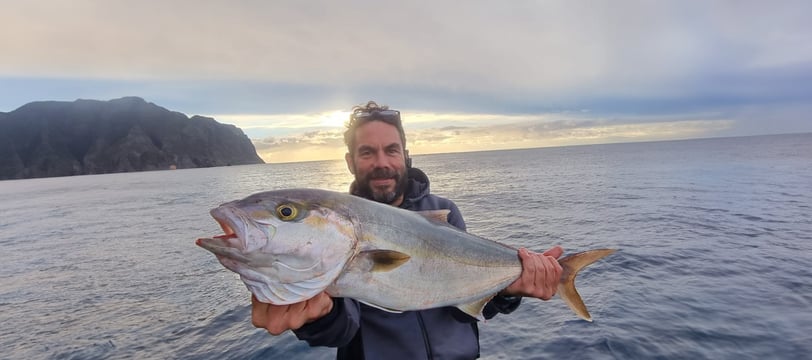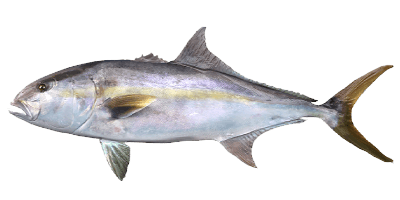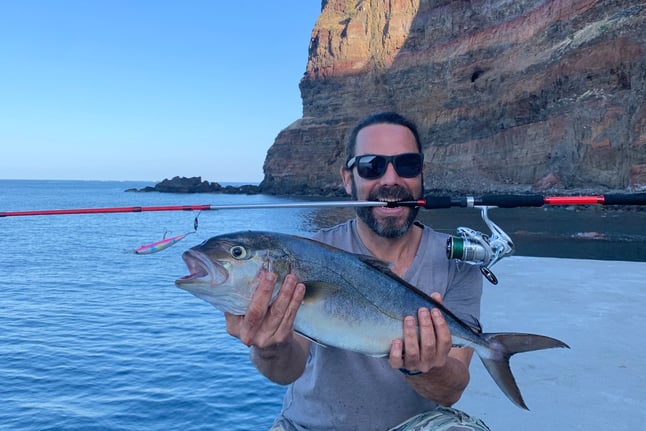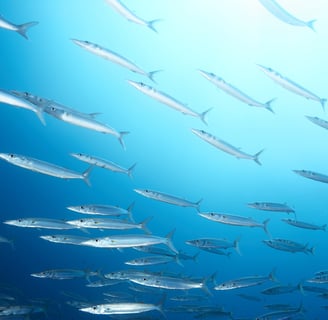Amberjack Fishing: Tactics and Challenges in Madeira
Discover Amberjack fishing in Madeira: techniques, challenges, best times, and tips for success.
FISHING TECHNIQUES


Madeira's waters are home to a wide variety of exciting species, and one of the most thrilling and challenging catches is the Amberjack (Seriola dumerili), also known locally as Charuteiro. Known for its immense power, large size, and remarkable intelligence, the Amberjack is a coveted target for seasoned anglers. This guide will provide everything you need to know about fishing for Amberjack in Madeira, including the best techniques, seasonal behaviour, fishing spots, and tips for tackling this powerful fish
Amberjack Overview
The Amberjack (Seriola dumerili) is a large, predatory fish belonging to the Carangidae family, which includes jacks and trevallies. Amberjacks are highly prized for their size, strength, and challenging fight. They are typically found in deep waters around submerged rocks, wrecks, and reefs, often hunting in strong currents. Amberjacks are aggressive predators that primarily feed on smaller fish such as sardines, anchovies, squid, and occasionally, crustaceans. Their size can range from smaller specimens to over 30 kg, and they are known to put up a fierce fight that can test an angler's strength and patience.
Challenges of Amberjack Fishing
Fishing for Amberjack is a test of skill and stamina. These fish are known for their incredible power and fighting ability, making them difficult to land, especially from shore. Amberjacks are capable of powerful runs and deep dives, often heading straight for underwater rocks or structure, where they can cut the line with their sharp teeth or get tangled in the reef. Experienced anglers are often required to have strong lines, heavy rods, and sturdy reels to withstand the Amberjack's strength. The intelligence of the Amberjack also comes into play—these fish are known for their ability to recognize danger and break free by cutting the line on the ocean floor, requiring the angler to stay vigilant and maintain constant tension during the fight.
Reproduction & Seasonality
Amberjacks spawn in deeper waters and are more abundant in Madeira from late spring to early autumn. However, they can be found year-round, especially in the deeper reefs around the island. The best times to fish for Amberjack in Madeira are typically during the summer months, especially when they are actively feeding and migrating in search of food. April through September tends to be the most productive period for targeting these powerful fish.
Fishing Techniques for Amberjack
Amberjacks are known for their strength, speed, and persistence, making them one of the most challenging species to catch from shore. Due to their size and strength, Amberjacks often require heavy-duty tackle and specialized fishing gear. Spinning, jigging, and live baiting are some of the most effective techniques for targeting them.
Jigging
Jigging is one of the most popular and effective methods for catching Amberjack. This technique involves dropping a heavy metal jig or soft lure into deep water and using quick, erratic movements to attract the Amberjack's attention. Amberjacks are often found around reefs and wrecks, so vertical jigging can be highly productive, especially when the fish are lurking near the bottom or in deeper waters. The key to success with jigging is fast, aggressive retrieves that mimic the movement of fleeing prey, such as small fish or squid.
Hard Bait Lures
Hard bait lures can be highly effective when targeting Amberjack, especially around rocky structures and underwater drop-offs. Both sinking and floating models have their place depending on water depth and fish activity. Sinking stickbaits, deep-diving minnows, and plugs work well for reaching deeper zones where Amberjack are often holding, while floating lures can trigger strikes near the surface during active feeding periods. Surface poppers are also highly effective, especially when Amberjack are feeding aggressively close to the surface creating loud splashes and vibrations that can provoke explosive strikes. A varied retrieve combining steady motion with sudden jerks or pauses can mimic the erratic behaviour of injured baitfish, provoking aggressive responses from nearby predators. When fish are schooling or actively hunting in mid-water or shallower areas, floating hard baits and poppers can be particularly successful.
Best Times for Spinning & Fishing Amberjack in Madeira
The summer months are generally the best time for targeting Amberjack in Madeira, especially from late spring to early autumn when they are most active. The fish can be found at deeper depths during colder months, but the best results are usually during warmer water temperatures. Morning and evening are prime times to target Amberjack, especially when they are feeding actively around reefs and submerged wrecks. The tides can also play a significant role in their feeding behaviour, and strong currents often provide the best conditions for catching these powerful fish.
Culinary Value of Amberjack
Amberjack is not only a challenging and exciting catch, but it also has great culinary value. The fish’s firm, mild-flavoured flesh makes it perfect for grilling, searing, or even preparing in a traditional fish stew. Amberjack can also be used for sashimi, particularly when it is fresh and high quality. The meat is rich in omega-3 fatty acids, making it both delicious and nutritious.
Conclusion
Amberjack is not only a challenging and exciting catch, but it also has great culinary value. The fish’s firm, mild-flavoured flesh makes it perfect for grilling, searing, or even preparing in a traditional fish stew. Amberjack can also be used for sashimi, particularly when it is fresh and high quality. The meat is rich in omega-3 fatty acids, making it both delicious and nutritious.
Amberjack Regulations
In the Autonomous Region of Madeira, the amberjack (Seriola dumerili) is a highly sought-after species. According to local regulations, any amberjack over 10 kg should be released back into the water. This is part of efforts to ensure the species' sustainability and protect its population, as larger amberjacks are often reproductive individuals crucial for maintaining a healthy fish stock. It’s important to follow these guidelines, practice responsible fishing, and respect size limits to help preserve the amberjack for future generations.













